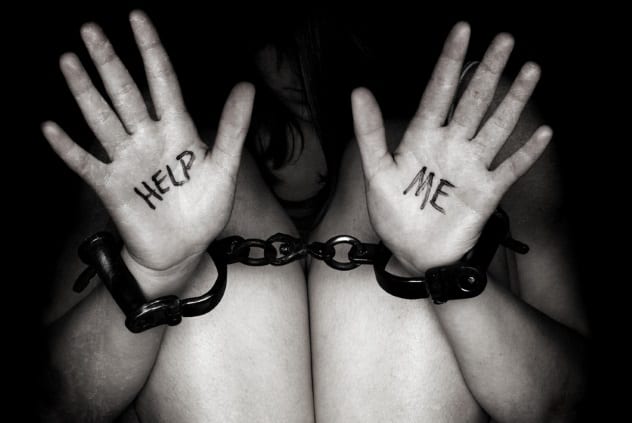 Mysteries
Mysteries  Mysteries
Mysteries  History
History 10 Surprising Stories About the Texas Rangers
 Humans
Humans 10 Philosophers Who Were Driven Mad by Their Own Theories
 Miscellaneous
Miscellaneous 10 Video-Game-Worthy Weapons and Armors from History
 Weird Stuff
Weird Stuff 10 Psychics Who Accurately Predicted Wartime Events
 The Arts
The Arts 10 Pieces of Art Inspired by a Broken Heart
 Health
Health 10 Science Fiction-Sounding New Medical Treatments
 History
History 10 Surprising Facts About the Father of Submarine Warfare
 Space
Space Ten Astonishing New Insights into Alien Worlds
 Weird Stuff
Weird Stuff 10 Bizarre Summer Solstice Rituals Still Practiced Today
 Mysteries
Mysteries Top 10 Haunting Facts About the Ghost Ship MV Alta
 History
History 10 Surprising Stories About the Texas Rangers
 Humans
Humans 10 Philosophers Who Were Driven Mad by Their Own Theories
Who's Behind Listverse?

Jamie Frater
Head Editor
Jamie founded Listverse due to an insatiable desire to share fascinating, obscure, and bizarre facts. He has been a guest speaker on numerous national radio and television stations and is a five time published author.
More About Us Miscellaneous
Miscellaneous 10 Video-Game-Worthy Weapons and Armors from History
 Weird Stuff
Weird Stuff 10 Psychics Who Accurately Predicted Wartime Events
 The Arts
The Arts 10 Pieces of Art Inspired by a Broken Heart
 Health
Health 10 Science Fiction-Sounding New Medical Treatments
 History
History 10 Surprising Facts About the Father of Submarine Warfare
 Space
Space Ten Astonishing New Insights into Alien Worlds
 Weird Stuff
Weird Stuff 10 Bizarre Summer Solstice Rituals Still Practiced Today
10 Supposedly Good Ideas That Backfired
Humans beings are inherent problem-solvers, as evidenced by having successfully made our way through the carnival of problems that has been our history. Sometimes, however, despite our best intentions, some of those solutions actually end up making the problem even worse than it was before.
You’ve probably heard the adage, “Necessity is the mother of invention.” But you’ve probably also heard that the road to Hell is paved with good intentions. The following solutions may have looked good on paper at the time, but they ended up horribly backfiring once they were actually put into practice.
10 Dead Whale Found On A Beach Blown Up With Dynamite
Photos of dead marine animals found on the beach make their way into the viral cycle every couple of months or so these days, though back in 1970, something like that was less “further proof of everything bad we’ve done to the oceans” and more, “Huh, what the hell is that?” So when a dead whale washed ashore in the town of Florence, Oregon, in 1970, the authorities tried to find the best way to get rid of it without causing any trouble for the nearby beachgoers. How did they go about it? By blowing it up with dynamite.
Yup, a bunch of adults, presumably people qualified to deal with such situations, figured it would be better to just blow up one of the biggest mammals on the planet and act like nothing happened instead of just putting it back in the water and letting the natural ecosystem dispose of it or at least calling other authorities. They also used a lot of dynamite so as to vaporize the small chunks of the exploding whale. Needless to say, the incident was a disaster; the sprayed bits not only showered the people nearby with some unwelcome and presumably stinking whale fluids but also severely damaged one of the cars parked there.[1]
9 French Effort To Eradicate Rats Gives Birth To Even More Rats

Whenever colonization is mentioned, the Brits get most of the blame, as they admittedly had the biggest empire of them all. Yet, many other European powers dabbled in it, many times reaching close to or even overtaking Britain as the most prolific colonizer of them all. France was one of them, with the jewel of their empire in Hanoi, Vietnam (then known as Indochina).
Hanoi was set up to be one of the best cities under French rule, though there was a tiny problem: rats. Because of the 14 kilometers (9 mi) of sewer pipe the French had set up under the city to keep things in order, rats could now reach any part of the city through them, making the problem worse. Finally having had enough of it, the French decided to put a bounty on the pesky creatures and asked the people to bring them dead rats for a small amount of money. Understandably not willing to go through rat carcasses at government offices, they decided to ask for only the tails of the rats.
At first, it seemed to be working quite well, as many tails were showing up, suggesting that the rats were dying, too. That wasn’t the case, though, as there were now even more rats than ever in the city. Unfortunately, the locals of Hanoi had actually turned it into a lucrative business, where they would only take the tail off the rats and let them go to back to producing even more baby rats for profit, because obviously they did. Because of that botched up bounty scheme, rats remain a big problem for the city of Hanoi even today.[2]
8 Prohibition Gave Way To The Mob

Despite the Prohibition era being an important development in American history, it’s hardly talked about as much as the other, more eventful time periods. Partly due to being overshadowed by much more important events around the same time—the immediate aftermath of World War I being one—and partly due to a time without alcohol not making for the most interesting conversations, Prohibition only occurs to most of us as an afterthought.
It started as a well-intentioned idea to curb violence, crime, and other ills of the time, and it had the support of the female suffrage movement, which saw alcohol as a major barrier to their goals due to the whole issue of “drunk men being drunk.”
While America did go through a brief period of prosperity in the 1920s, and Prohibition did help with some things it meant to, what it mostly did was act as an incubator for the Mafia. You see, even if alcohol was banned, people who wanted booze were still very much around, and they were ready to pay a premium for it. Speakeasies sprang up across the country, and small-time criminals started moving en masse to the most lucrative gig of the time—bootlegged alcohol—and started making fortunes off it as well as consolidating themselves around rigid factions.
Prohibition brought about the rise of organized crime in America and would remain its most lasting legacy.[3] Take Al Capone for an example; he made his empire entirely on the back of speakeasies and casinos in Prohibition-era Chicago and probably would have remained a small-time gangster if not for that era.
7 A Plan To Stop Child Marriages Made The Dowry System Even Worse

For those who haven’t been tuned into world affairs, India is one of the worst countries for women, as evidenced by the still-existing dowry system, rampant sexual violence, and overall sex ratio. While many may attribute it to the incompetent government (which may even be true), it’s not like they haven’t been trying to fix it. From initiatives meant to educate girls and stricter laws against sexual assault, they’ve tried it all, to no avail. What’s also not helping is the fact that some of their efforts meant to help things have actually made it worse.
In a plan introduced in 1994, the government attempted to put a stop to child marriages by promising a lump sum amount for every girl born in the state of Haryana, provided that they stay unmarried till they’re 18. Sounds pretty sensible, doesn’t it? It wasn’t, as that didn’t do anything to fix the underlying problems that led to child marriages. The lump sum promised soon started being offered to the potential groom as an even bigger amount of dowry, making the problem worse than it was before. It did stop the child marriages, mostly because the parents would wait until the girls turned 18, receive the money, put it into the dowry, and marry them off as soon as they could like usual.[4]
6 Global Agreement To Limit Emissions Increases Emissions

When we talk about climate change, we still discuss it as something in the future, even though we’ve already started seeing its effects in action. The scientists and other concerned professionals talking about it have moved well past “be careful” to “told you so,” though even now, many countries are reluctant to do something about it. Not just that, but many of our solutions have actually ended up making the problem worse, case in point being the Kyoto Protocol.
The Kyoto Protocol was a coming together of many countries to collectively discuss and implement solutions to the ever-increasing problem of global warming. One of the decided solutions was the Joint Implementation program, under which countries would be rewarded for burning harmful gases instead of letting them into the atmosphere and could earn tradable credits based on whatever amount they burned. Those credits could then be sold to other countries, which could then sell them to someone else depending on how much of their quota they fulfilled, keeping the overall carbon footprint in balance. The problem, however, was that these credits weren’t actually real, and all they ended up doing was giving some countries an incentive to burn even more gas to generate more credits, which they absolutely did, because why wouldn’t they?
All in all, the whole thing ended up adding around 600 million metric tons of excess emissions into the atmosphere and made for a good “what not to do” item on the list of things they talked about during the subsequent climate change treaty, the Paris Agreement.[5]
5 Legalizing Prostitution Increased The Rate Of Human Trafficking

Prostitution is a tricky subject to tackle, even if it’s the world’s oldest profession and really shouldn’t be. While activists have been asking for it to be legalized the world over to put an end to the stigma sex workers face and all the human trafficking that comes with it, policymakers often cite reasons like morality to keep things as they are. That’s not to say that countries haven’t tried to legalize prostitution to see what happens, though in most cases, it has ended up backfiring.
It stands to reason that making prostitution legal should put an end to human trafficking, though for countries like Germany and Denmark, which legalized prostitution near the turn of the 21st century, the results have been the exact opposite. According to studies, human trafficking has been on a rise ever since they did, and in countries which criminalized it after a long period of time, like Sweden, trafficking rates were found to be shrinking.[6]
So, what gives? These countries aren’t isolated from the rest of the world, where human trafficking is still thriving. It makes sense that by legalizing prostitution, they gave the traffickers even more markets to operate in, though now with government backing and a crime-free environment.
4 Green Scheme Destroys Country’s Renewable Industry And Dissolves Its Government

Renewable energy is the blockchain of 2019, in the sense that it’s the new industry everyone is moving into without fully knowing how it works. Governments the world over are investing in “green” technologies, not just to battle climate change but also as a sound opportunity to invest in the future. So, in 2012, when Northern Ireland introduced the Renewable Heat Incentive—a government program to incentivize the use of renewables by subsidizing the energy costs for anyone using them—little did it know that it wouldn’t end up doing either of those two things, and their actions would mean the end of both the government and the renewable sector in NI.[7]
You see, what the scheme offered was money to anyone who had a lot of smaller renewable heating systems installed at their workplace instead of one big one, thinking that it would encourage renewable use as well as future-proof the local industries. What people took that to mean was, “The more heating systems we have running, the more money we can get out of the government” because of course they did. At one point, businesses were keeping all of their heating systems operational 24/7 to avail the maximum amount of money from the subsidy. By the end of it, the scheme ended up costing the taxpayers some £490 million and caused the renewable industry to collapse as well as the joint government that introduced it to dissolve due to the fallout.
3 Regulation To Encourage Small Cars Caused An Abundance Of Bigger SUVs And Trucks

The US is perhaps one of the few countries where bigger and heavier automobiles are popular, and smaller cars, while still aplenty, are not really preferred by the consumers if they have a choice (like more money). It goes against common wisdom, as government regulations should promote smaller, more fuel-efficient vehicles to conserve oil as well as reduce the overall carbon footprint. As it turns out, one of the US government’s policies to do exactly that backfired over time.
It all goes back to the 1973 oil crisis, when a bunch of Arab countries imposed an embargo on all the countries that supported Israel in the Yom Kippur War. Oil became insanely expensive and hard to obtain, which led the US government to introduce a new set of rules to promote smaller, more efficient vehicles instead of bigger ones. Known as CAFE (Corporate Average Fuel Economy), these rules put stringent checks on the fuel efficiency of smaller vehicles, requiring that all the small cars hitting the market meet minimum fuel economy targets. On paper, it sounds perfect, as it would force carmakers to make better, more efficient small cars, as well as encourage buyers to go for them instead of bigger vehicles. In practice, it ended up doing the exact opposite.
What was actually, “Smaller cars need to have better fuel economy,” was read by carmakers as, “Bigger vehicles don’t need to care about fuel economy,” as the checks on the latter were far less strict. As a result, auto companies simply started rolling out more SUVs and pickup trucks instead of smaller cars, and because of that, the consumers also started preferring more room and bigger vehicles than their smaller counterparts, as the options are readily available.[8]
2 Smoking Bans Cause A Rise In Drunk Driving Fatalities

Smokers (including the writer of this article) tend to justify their habit by freedom of choice but often conveniently forget that part when lighting one up in public spaces. Sure, it’s not like they’re blowing smoke in other people’s faces, but for someone who doesn’t smoke, it’s terribly inconvenient to even catch a whiff of it from a distance. There are no easy or black and white solutions to this; just as someone has the freedom to smoke anywhere, other people also have the freedom to not have to breathe that smoke if they don’t want to. You could try outright banning smoking in public places and force the smokers to either quit or head to a smoking zone, as many places in the US have done at various points in time, though that hasn’t worked out too well, either.
In a study conducted in the Journal of Public Economics, researchers studied data from 120 counties, 20 of which were smoke-free. They figured that people who weren’t allowed to smoke at a bar must be going somewhere to do it, as anyone who has met a smoker will tell you. And yup, they were right; in the smoke-free counties, drunk driving was found to be on the rise by as much as 19 percent. And the fatalities weren’t just limited to the places that banned smoking; neighboring areas also saw a sharp rise (by as much as 40 percent!) in cases of drunk driving immediately after smoking bans went into effect.[9]
1 Anti-Bullying Campaign Actually Helped Bullies To Identify Potential Targets

Bullying is one of the most important issues facing students at all levels and grades. Not only does it create an unhealthy environment for the others, but it also leaves the victims with years of trauma, lowered self-esteem, and a bunch of other issues that stay for life. It’s also a tricky problem to handle, as the ones on the receiving end of it seldom speak up due to fear of retribution. So when Bullywatch, an organization that donated all its proceeds to families of bullying victims, came up with their own distinct wristband to be worn by anyone who was against bullying as a gesture of unity against the bullies, they had their heads in the right place.
Unfortunately, one important thing they failed to consider was how a bully’s mind actually works. What others may have seen as a pretty powerful message against bullies and harassment, the bullies saw as a marker for who to bully next.[10] The kids wearing the wristband were reported to have been especially targeted for bullying, something this whole idea was meant to stop and fight against. If you ask us, though, this whole thing could have been avoided if they had just consulted a bully/ex-bully before embarking on this project.
You can check out Himanshu’s stuff at Cracked and Screen Rant, get in touch with him for writing gigs, or just say hello to him on Twitter.
Read about more best-laid plains that went up in flames on Top 10 Harebrained Celebrity PR Stunts That Backfired Spectacularly and 10 Environmentally Conscious Actions That Backfired In Strange Ways.








